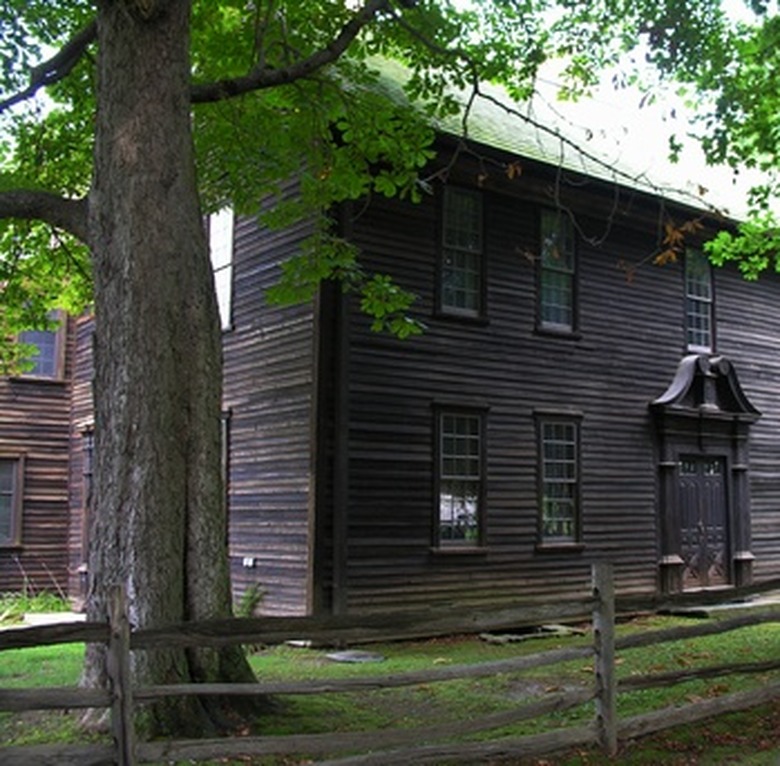How To Repair Horsehair Plaster
Things Needed
-
Paint brush
-
Sponge
-
Water
-
Silicone caulking
-
Putty knife
-
Mesh tape
-
Mesh panels
-
Screw gun
-
Screws
-
Joint compound
-
Face mask
-
Protective goggles
-
Sandpaper in coarse, medium and fine grits
-
Sanding block or random orbital sander
Homes that are 100 years old or more are apt to have horsehair plaster and lath instead of drywall or plasterboard; it wasn't until the 1950s that drywall replaced the use of plaster and lath. Horsehair plaster is very prone to cracking and crumbling due to age, so frequent repairs are often necessary. Due to the crumbly nature of horsehair plaster, it's a bit harder to repair the defects and damage.
Step 1
Remove crumbling pieces of plaster and larger plaster particles by hand. Use a dry paint brush to clear away smaller particles of plaster.
Step 2
Wipe the area with a damp sponge to remove dust and plaster dust particles from inside the damaged area. Also wipe down the wall surrounding the defect.
Step 3
Insert silicone caulking into small cracks (less than a half inch) in the plaster. This will allow the joint to expand and contract without causing further disintegration.
Step 4
Place a strip of mesh tape over cracks. For areas of crumbling plaster or damaged corners, screw a metal mesh panel to the wall to cover the defect. The mesh will serve as a skeleton for the joint compound.
Step 5
Apply joint compound onto the mesh panel/tape covering the defect using a large putty knife. Apply joint compound to the surrounding wall, too. Work in large sweeping strokes as you cover the defect and surrounding area. Work quickly, as some joint compound formulas dry very quickly.
Step 6
Wait for the joint compound to dry. The drying time varies depending on the product, so read the packaging to determine how long you must wait before sanding.
Step 7
Don protective goggles and a face mask.
Step 8
Sand the joint compound using coarse grit sandpaper on a sanding block or a random orbital sander. Work in circular strokes to smooth the joint compound and to remove imperfections.
Step 9
Switch to a medium grit sandpaper, followed by a fine grit sandpaper. Continue working in a circular motion, smoothing the joint compound and removing marks left by the coarser grit. Blend the edges of the area of joint compound into the surrounding wall.
Tip
Avoid filling cracks or holes with joint compound. The joint compound tends to shrink when drying and it expands at a different rate (vs. the horsehair plaster), resulting in cracks. Use caulking instead, as it will expand and contract with the wall. The mesh "floats" over the crack/defect, thereby lessening the chance of cracks or disintegration in the future.
For large sections of crumbling horsehair plaster, it's generally best to rip out the entire wall and replace it with drywall.
During the sanding process (step 8), you may find that you have dips or craters in the joint compound. If necessary, you can fill them in by applying another coat of joint compound to the affected area. Then, repeat the sanding process.
An oil-based primer/sealer is ideal for use on horsehair plaster that's going to be painted.
Many walls with horsehair plaster have a gritty texture; the newly-repaired section of wall will have a smooth texture. You can create uniformity by applying a skim coat of joint compound to smooth the entire wall or you use a textured paint to create a uniform gritty texture. Horsehair plaster walls are also ideal for faux finishing methods, which can hide the imperfections that are often present.
Warning
Always wear a face mask when sanding to avoid inhaling airborne particles.
Always wear protective goggles when sanding to prevent eye injuries or irritation from the dust.
References
- Mark Hardin; Owner, Hardin's Handyman Service; Fort Myers, Florida
